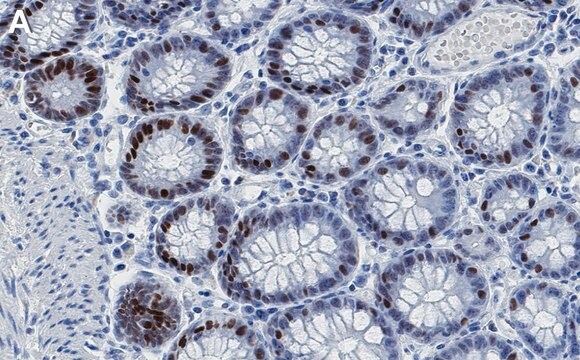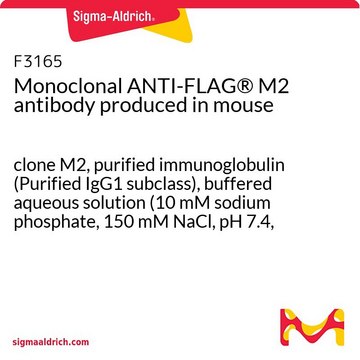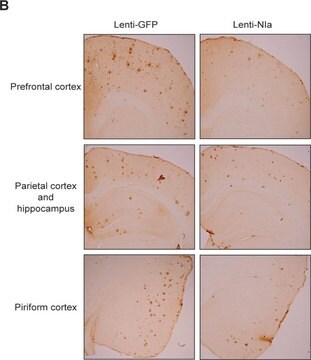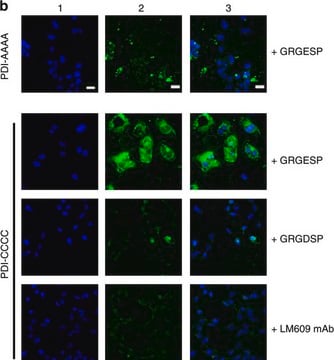MABN2728
Anti-FoxA2/HNF-3b Antibody, clone 4C7
Synonim(y):
Czynnik jądrowy hepatocytów-3beta, HNF-3 beta, FOXA2, Skrzynka widełkowa A2
About This Item
Polecane produkty
pochodzenie biologiczne
mouse
Poziom jakości
forma przeciwciała
purified antibody
rodzaj przeciwciała
primary antibodies
klon
4C7, monoclonal
masa cząsteczkowa
calculated mol wt 47.23 kDa
observed mol wt ~50 kDa
oczyszczone przez
using protein G
reaktywność gatunkowa
human, chicken, mouse
opakowanie
antibody small pack of 100
metody
electron microscopy: suitable
immunocytochemistry: suitable
immunofluorescence: suitable
immunohistochemistry: suitable
immunoprecipitation (IP): suitable
western blot: suitable
izotyp
IgG1κ
sekwencja epitopowa
Unknown
numer dostępu Protein ID
numer dostępu UniProt
temp. przechowywania
2-8°C
informacje o genach
chicken ... HNF-3beta(395539)
Specyficzność
Immunogen
Zastosowanie
Oceniane metodą Western Blotting w lizacie komórek HepG2.
Analiza Western Blotting: Rozcieńczenie 1:500 tego przeciwciała wykryło FoxA2/HNF-3b w lizacie komórek HepG2.
Testowane aplikacje
Electrophoretic Mobility Shift Assay: Reprezentatywna partia wykryła FoxA2/HNF-3b w Electrophoretic Mobility Shift Assay (EMSA) (Foucher, I., et al. (2003). Development. 130(9): 1867-76).
Analiza immunofluorescencyjna: Reprezentatywna partia wykryła FoxA2/HNF-3b w zastosowaniach immunofluorescencji (Camp, D., et al. (2014). Development. 141(20): 3879-88; Hoelzl, M.A., et al. (2017). Dev Biol. 429(1): 132-146).
Analiza immunoprecypitacji: Reprezentatywna partia immunoprecypitowana FoxA2/HNF-3b w zastosowaniach immunoprecypitacji (van den Brink, G.R., et al. (2001). Gastroenterology. 121(2):317-28).
Zastosowania immunohistochemiczne: Reprezentatywna partia wykryła FoxA2/HNF-3b w zastosowaniach immunohistochemicznych (Ericson, J., et al. (1996). Cell. 87(4):661-73; Kwon, O., et al. (1998). J Clin Invest. 101(10):2054-64; Rousa, F.M., et al. (2000). Mol Cell Biol. 20(21):8264-82; van den Brink, G.R., et al. (2001). Gastroenterology. 121(2):317-28; Camp, D., et al. (2014). Development. 141(20):3879-88; Hoelzl, M.A., et al. (2017). Dev Biol. 429(1):132-146; Amarnath, S., et al. (2017). J Cell Sci. 130(1):119-131).
Analiza immunocytochemiczna: Reprezentatywna partia wykryła FoxA2/HNF-3b w zastosowaniach immunohistochemicznych (Nagase, T., et al. (2009). Dev Dyn. 238(5):1118-30).
Analiza Western Blotting: Reprezentatywna partia wykryła FoxA2/HNF-3b w zastosowaniach Western Blotting (Rousa, F.M., et al. (2000). Mol Cell Biol. 20(21):8264-82; van den Brink, G.R., et al. (2001). Gastroenterology. 121(2):317-28).
Uwaga: Rzeczywiste optymalne rozcieńczenia robocze muszą być określone przez użytkownika końcowego jako próbki, a warunki eksperymentalne mogą się różnić w zależności od użytkownika końcowego.
Opis wartości docelowych
Postać fizyczna
Rekonstytucja
Przechowywanie i stabilność
Inne uwagi
Oświadczenie o zrzeczeniu się odpowiedzialności
Nie możesz znaleźć właściwego produktu?
Wypróbuj nasz Narzędzie selektora produktów.
Kod klasy składowania
12 - Non Combustible Liquids
Klasa zagrożenia wodnego (WGK)
WGK 1
Temperatura zapłonu (°F)
Not applicable
Temperatura zapłonu (°C)
Not applicable
Certyfikaty analizy (CoA)
Poszukaj Certyfikaty analizy (CoA), wpisując numer partii/serii produktów. Numery serii i partii można znaleźć na etykiecie produktu po słowach „seria” lub „partia”.
Masz już ten produkt?
Dokumenty związane z niedawno zakupionymi produktami zostały zamieszczone w Bibliotece dokumentów.
Nasz zespół naukowców ma doświadczenie we wszystkich obszarach badań, w tym w naukach przyrodniczych, materiałoznawstwie, syntezie chemicznej, chromatografii, analityce i wielu innych dziedzinach.
Skontaktuj się z zespołem ds. pomocy technicznej








